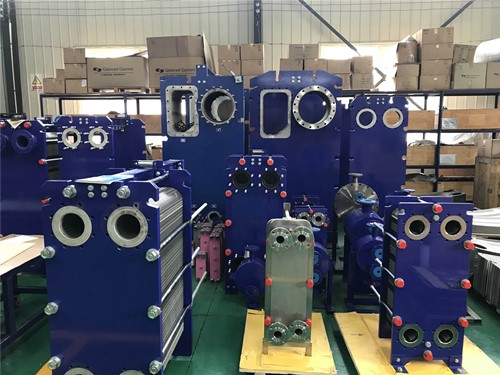How can we reduce the resistance of plate heat exchangers?
Plate heat exchanger resistance will have a direct impact on the plate heat exchanger heat transfer efficiency, so do you know how to reduce the plate What about the resistance of the heat exchanger? The following authors are here to introduce you.
1. Using hot mixing board
The two sides of the thermal hybrid plate have the same corrugated geometry, and the plate is divided into a hard plate (H) and a soft plate (L) according to the angle of the zigzag corrugations. The angle (usually about 120.) is greater than 90. is hard board, the angle (usually about 70.) is less than 90. is soft board. . Heat mixing plate hard plate surface heat transfer coefficient is high, fluid resistance, soft plate is the opposite. Combination of hard plate and soft plate, can be composed of high (HH), in (HL), low (LL) 3 characteristics of the flow channel, to meet the different The demand of working conditions.

Hot and cold medium flow is relatively large, the use of thermal mixing plate than the use of symmetrical single-flow heat exchanger can reduce the plate area. Hot mixed plate hot and cold on both sides of the hole diameter is usually equal, hot and cold medium flow than the large, cold medium side of the corner pressure loss L very large. In addition, the thermal mixing plate design technology is difficult to achieve precise matching, often resulting in limited savings in plate area. Therefore, the hot and cold medium flow ratio is too large to use the hot mixed plate.
2. The use of asymmetric plate heat exchanger
Symmetrical plate heat exchanger is composed of plates with the same corrugated geometry on both sides of the plate, forming a plate with equal cross-sectional area of hot and cold runner circulation. Heat exchanger. Asymmetric (unequal cross-sectional area) plate heat exchanger according to the heat transfer characteristics of the cold and hot fluid and pressure drop requirements, change the waveform on both sides of the plate. Geometric structure, the formation of hot and cold runner circulation cross-sectional area of varying plate heat exchanger, wide runner side of the corner of the larger L diameter. Asymmetric plate heat exchanger coefficient of heat transfer decreased slightly, and the pressure drop is greatly reduced. Hot and cold medium flow is relatively large, the use of non-symmetrical single process than the use of symmetrical single process heat exchanger can reduce the plate area of 15%. A 3O%.
3. Adopt a multi-process portfolio
When the hot and cold media flow is large, a combined multi-flow arrangement can be used, with more flow on the small flow side to increase the flow rate. Higher heat transfer coefficients are obtained. Fewer flows are used on the high flow side to reduce heat exchanger resistance. A multi-flow combination results in a mixed flow pattern with a slightly lower average heat transfer temperature difference. The combination of multi-process plate heat exchanger fixed end plate and active end plate have taken over, maintenance workload.
4. Set heat exchanger bypass tube
When the hot and cold medium flow is relatively large, the heat exchanger in the large flow side of the import and export side of the heat exchanger can be set up to bypass the tube to reduce the flow into the heat exchanger. Reduce resistance. In order to facilitate adjustment, in the bypass tube should be installed on the control valve. The way should be used to counter-current arrangement, so that the cold medium out of the heat exchanger temperature is high, to ensure that the heat exchanger outlet after the merger of the cold medium temperature can be To meet the design requirements. Set heat exchanger bypass tube can ensure that the heat exchanger has a high heat transfer coefficient, reduce heat exchanger resistance, but the adjustment is slightly complicated.
5. Plate heat exchanger form of choice
Heat exchanger between the plate runner medium in the average flow rate of 0.3 ~ 0.6m / s is appropriate, resistance to not more than 100kPa is appropriate. According to different hot and cold medium flow than, can refer to Table 1 selection of different forms of plate heat exchanger, the table non-symmetrical plate heat exchanger flow channel The cross-sectional area ratio is 2. Symmetrical or asymmetrical, single or multi-process plate heat exchanger can be set up with heat exchanger bypass tube. But it should be subjected to detailed thermal calculations.
The above is the author's introduction of how to reduce the resistance of plate heat exchanger, I hope it can help you, if you still have other aspects you want to know, you can come to consult us.
Related information
- The first semi welded titanium type plate evaporator in China
- The conditions of using expansion joint of plate heat exchanger
- Coal Chemical Industry - Application Case Study of Plate and Shell Heat Exchanger
- Pharmaceutical chemical plate heat exchanger selection of double-walled plate is imperative, safety issues are always in the first place
- Qingdao Ruipute introduce you to the clean room using stainless steel plate heat exchanger how to maintenance
- What are the advantages of industrial plate heat exchangers in applications
Relevant article
- 1
- Can plate heat exchanger be directly used for feed water heating or cooling?
- Why the heat transfer efficiency of plate heat exchangers in the heating industry is low
- How to determine the size and angle of plate heat exchanger plate?
- What is the proportion of pressure drop in the selection of plate heat exchanger?
- Why do we recommend food grade plate heat exchanger for beer brewing and fermentation? What should we pay attention to?
- What is the difference between the hanging holes on the plate of plate heat exchanger?
- What are the applications of plate and shell heat exchanger in the field of petroleum refining
- What is the key to the manufacture of plate heat exchangers with small temperature differences?
- How to descale the plate heat exchanger? What problems should be paid attention to during use?
Latest information
- Heat station supporting plate heat exchanger installation is a technical work, these points should be noted
- Sulfuric acid and other corrosive media for industrial plate heat exchanger requirements are what
- Simple and effective chemical cleaning method of coal chemical plate heat exchanger, can effectively improve efficiency
- A high-quality petrochemical plate heat exchanger in the production of what to consider
- These causes of chemical plate heat exchanger gasket aging you may not know
- Chemical plant plate heat exchanger, sulfuric acid cooling needs attention
- High-end plate heat exchanger customization, specifically for your special working conditions
- The working principle of gasket type industrial plate heat exchanger and the scenarios of its use are worth knowing in depth
- Still worrying about the wholesale price of industrial plate heat exchangers? An article to make you no longer tangled
- The original lubricant in the chemical plate heat exchanger plays so many roles!








